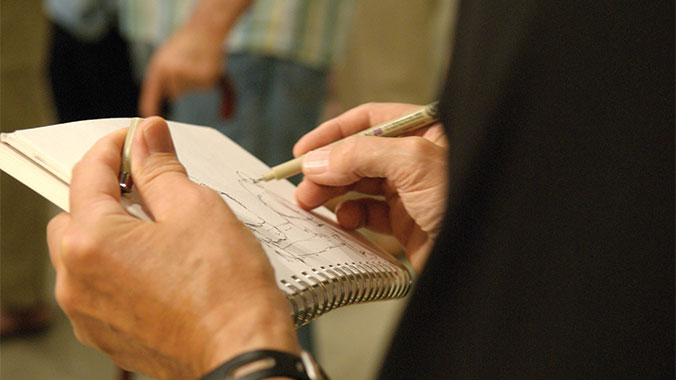Learning to Draw by Sketching the Great Buildings of the World

Have you always wanted to improve your drawing skills? Join us for our new series of virtual lectures focused on architectural drawing. No formal drawing experience is necessary.
To get the most out of your class, Professor Keane recommends that you take a moment to prepare these items before his lecture:
1. Print out the base drawing for your lecture. Please note there is a separate base drawing for each lecture. These templates will guide your sketches during the lectures and are helpful for everyone regardless of skill-level:
Program #24919 | Wednesday, Mar. 20, 2024, at 4 p.m. (ET)
Online Lecture Series: Learn to Sketch the UNESCO Sites - Chartres Cathedral
Program #24946 | Wednesday, Apr. 17, 2024, at 4 p.m. (ET)
Online Lecture Series: Learn to Sketch the UNESCO Sites - India’s Taj Mahal
Program #24930 | Monday, May 13, 2024, at 4 p.m. (ET)
Online Lecture Series: Learn to Sketch the UNESCO Sites - China Imperial Palace
Program #24931 | Tuesday, May 14, 2024, at 4 p.m. (ET)
Online Lecture Series: Learn to Sketch the UNESCO Sites - Japan’s Kinkaku-ji
Program #24932 | Wednesday, May 15, 2024, at 4 p.m. (ET)
Online Lecture Series: Learn to Sketch the UNESCO Sites - Cambodia’s Angkor Wat
Program #24957 | Wednesday, Jun. 12, 2024, at 4 p.m. (ET)
Online Lecture Series: Learn to Sketch the UNESCO Sites - Jordan’s Al-Khazneh
Program #24958 | Wednesday, Jul. 17, 2024, at 4 p.m. (ET)
Online Lecture Series: Learn to Sketch the UNESCO Sites - Palace of Versailles
Program #24959 | Wednesday, Aug. 14, 2024, at 4 p.m. (ET)
Online Lecture Series: Learn to Sketch the UNESCO Sites - London’s Tower Bridge
2. Use white or light color standard 8.5 x 11 size paper.
3. Sharpen 3 pencils. A black Prismacolor® pencil is preferred, but a standard #2 pencil will also work. Prismacolor® colored pencils allow you to have the best range for shading (going from very light to completely black).
You can find Prismacolor® colored pencils at major craft stores (such as Michael's) art supply stores or on Amazon.com.
4. Highly recommended, but not required — watch Professor Keane’s 30-minute video that covers some basic drawing concepts.
Watch this past lecture for a sneak peek at what a drawing lecture is like:
Online Lecture: Hands-On With an Architect, Drawing Notre Dame de Paris
Download the base drawing and watch this lecture for free!
FAQs
What if I don’t have a printer and don’t have the base drawing printed before the lecture?
The base drawing is provided as a helpful tool that makes it easy to follow Professor Keane’s instructions. The class can be done with a blank piece of paper for those more experienced in sketching. There will be a perspective drawing demo/review to start the session. We also recommend that you watch this video to prepare yourself with some basic architectural/drawing knowledge.
What if I only have #2 pencils?
While you can use what you have, a regular #2 pencil simply does not provide pure black. The recommended Prismacolor® (or other brand of black color pencil) will give you control over the shading aspects of your drawing.
I don’t have any drawing experience, is this class for me?
All humans were born to draw, as we drew before we had language. Professor Keane also believes that drawing is good for your health. Start with one drawing and keep going to improve your technique. You can always stop the recording and continue at your pace.
Can I sketch on my iPad/tablet and use a smart pencil to draw on it?
While we recommend physical paper and black color pencil drawing for this class, if you prefer to draw over the base drawing sheet scanned into your unit, that is acceptable.
Can you watch the lecture on the same device at the same time?
If you choose to use your tablet to draw, you will need to have a separate screen so you can watch Professor Keane and draw along as he lectures.
How can I learn more about how drawing is good for your health?
There has been a great deal of research on this topic. Here are some resources to learn more:
“Why Draw” by Mark Keane
Drawing is better than writing for memory retention by the University of Waterloo
Feeling Artsy? Here’s How Making Art Helps Your Brain by Malaka Gharib
How do I find out more about the instructor?
Professor Keane can be found via his architectural practice: http://www.studio1032.com/ or via his K-12 design education non-profit: www.NEXT.cc


